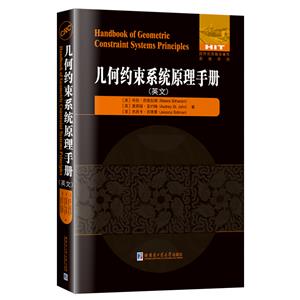掃一掃
關注中圖網
官方微博
幾何約束系統原理手冊:英文 版權信息
- ISBN:9787576709414
- 條形碼:9787576709414 ; 978-7-5767-0941-4
- 裝幀:平裝-膠訂
- 冊數:暫無
- 重量:暫無
- 所屬分類:>>
幾何約束系統原理手冊:英文 內容簡介
本手冊旨在作為當前使用的基本數學和計算工具、方法和結果的切入點。它誕生于對包含核心原理和結果的單一來源的持續需求,初學者和專家(從剛剛開始進行研究的研究生到對應用感興趣的代數幾何學家,再到尋求制造一批自主代理的機器人專家)都可以理解。希望本書可以成為讀者掌握GCS研究中的概念、方法和結果的有效工具。
本書的目的是為那些希望熟悉基礎知識的人以及希望在廣闊的領域中確定具體結果或方法的專家提供資源,旨在將讀者從一般的代數幾何方法帶入更專業的包含組合分析和高效算法的語境之中。章節按所使用的主要方法進行分組,希望讀者能夠找到***他們的專業知識的材料。
幾何約束系統原理手冊:英文 目錄
Foreword
Preface
Contributors
1 Overview and Preliminaries
Meera Sitharam and Troy Baker
1.1 Introduction
1.1.1 Specifying a GCS
1.1.2 Fundamental GCS Questions
1.1.3 Tractability and Computational Complexity
1.2 Parts and Chapters of the Handbook
1.2.1 Part I:Geometric Reasoning Techniques
1.2.2 Part II:Distance Geometry,Configuration Space,and Real Algebraic Ge-ometry Techniques
1.2.3 Part III:Geometric Rigidity Techniques
1.2.4 Part IV:Combinatorial Rigidity Techniques
1.2.4.1 Inductive Constructions
1.2.4.2 Body Frameworks
1.2.4.3 Body-Cad,and Point-Line Frameworks
1.2.4.4 Symmetric and Periodic Frameworks and Frameworks under Polyhedral Norms
1.2.5 Missing Topics and Chapters
1.3 Terminology Reconciliation and Basic Concepts
1.3.1 Constrainedness
1.3.2 Rigidity of Frameworks
1.3.3 Generic Rigidity of Frameworks
1.3.4 Approximate Degree-of-Freedom and Sparsity
1.4 Alternative Pathway through the Book
I Geometric Reasoning,Factorization and Decomposition
2 Computer-Assisted Theorem Proving in Synthetic Geometry Julien Narboux,Predrag Jani?i?,and Jacques Fleuriot
2.1 Introduction
2.2 Automated Theorem Proving
2.2.1 Foundations
2.2.2 Nondegenerate Conditions
2.2.3 Purely Synthetic Methods
2.2.3.1 Early Systems
2.2.3.2 Deductive Database Method,GRAMY,and iGeoTutor
2.2.3.3 Logic-Based Approaches
2.2.4 Semisynthetic Methods
2.2.4.1 Area Method
2.2.4.2 Full-Angle Method
2.2.4.3 Vector-Based Method
2.2.4.4 Mass-Point Method
2.2.5 Prover s Implementations and Repositories of Theorems
2.3 Interactive Theorem Proving
2.3.1 Formalization of Foundations of Geometry
2.3.1.1 Hilbert's Geometry
2.3.1.2 Tarski’s Geometry
2.3.1.3 Axiom Systems and Continuity Properties
2.3.1.4 Other Axiom Systems and Geometries
2.3.1.5 Meta-Theory
2.3.2 Higher Level Results
2.3.3 Other Formalizations Related to Geometry
2.3.4 Verified Automated Reasoning
3 Coordinate-Free Theorem Proving in Incidence Geometry
Jürgen Richter-Gebert and Hongbo Li
3.1 Incidence Geometry
3.1.1 Incidence Geometry in the Plan e
3.1.2 Other Primitive Operations
3.1.3 Projective Invariance
3.2 Bracket Algebra:Straightening,Division,and Final Polynomials
3.2.1 Bracket Algebra and Straightening
3.2.2 Division
3.2.3 Final Polynomials
3.3 Cayley Expansion and Factorization
3.3.1 Cayley Expansion
3.3.2 Cayley Factorization
3.3.3 Cayley Expansion and Factorization in Geometric Theorem Proving
3.3.4 Rational Invariants and Antisymmetrization
3.4 Bracket Algebra for Euclidean Geometry
3.4.1 The Points I and J
3.4.2 Proving Euclidean Theorems
4 Special Positions of Frameworks and the Grassmann-Cayley Algebra
Jessica Sidman and William Traves
4.1 Introduction:the Grassmann-Cayley Algebra and Frameworks
4.2 Projective Space
4.2.1 Motivation
4.2.2 Homogeneous Coordinates and Points at Infinity
4.2.3 Equations on Projective Space
4.2.4 Duality Between Lines and Points in IP2
4.2.5 Grassmannians and Plücker Coordinates
4.2.6 More About Lines in 3-space
4.3 The Bracket Algebra and Rings of Invariants
4.3.1 Group Actions and Invariant Polynomials
4.3.2 Relations Among the Brackets
4.4 The Grassmann-Cayley Algebra
……
II Distance Geometry, Real Algebraic Geometry, and Configuration Spaces
III Geometric Rigidty
IV Combinatorial Rigidity
Preface
Contributors
1 Overview and Preliminaries
Meera Sitharam and Troy Baker
1.1 Introduction
1.1.1 Specifying a GCS
1.1.2 Fundamental GCS Questions
1.1.3 Tractability and Computational Complexity
1.2 Parts and Chapters of the Handbook
1.2.1 Part I:Geometric Reasoning Techniques
1.2.2 Part II:Distance Geometry,Configuration Space,and Real Algebraic Ge-ometry Techniques
1.2.3 Part III:Geometric Rigidity Techniques
1.2.4 Part IV:Combinatorial Rigidity Techniques
1.2.4.1 Inductive Constructions
1.2.4.2 Body Frameworks
1.2.4.3 Body-Cad,and Point-Line Frameworks
1.2.4.4 Symmetric and Periodic Frameworks and Frameworks under Polyhedral Norms
1.2.5 Missing Topics and Chapters
1.3 Terminology Reconciliation and Basic Concepts
1.3.1 Constrainedness
1.3.2 Rigidity of Frameworks
1.3.3 Generic Rigidity of Frameworks
1.3.4 Approximate Degree-of-Freedom and Sparsity
1.4 Alternative Pathway through the Book
I Geometric Reasoning,Factorization and Decomposition
2 Computer-Assisted Theorem Proving in Synthetic Geometry Julien Narboux,Predrag Jani?i?,and Jacques Fleuriot
2.1 Introduction
2.2 Automated Theorem Proving
2.2.1 Foundations
2.2.2 Nondegenerate Conditions
2.2.3 Purely Synthetic Methods
2.2.3.1 Early Systems
2.2.3.2 Deductive Database Method,GRAMY,and iGeoTutor
2.2.3.3 Logic-Based Approaches
2.2.4 Semisynthetic Methods
2.2.4.1 Area Method
2.2.4.2 Full-Angle Method
2.2.4.3 Vector-Based Method
2.2.4.4 Mass-Point Method
2.2.5 Prover s Implementations and Repositories of Theorems
2.3 Interactive Theorem Proving
2.3.1 Formalization of Foundations of Geometry
2.3.1.1 Hilbert's Geometry
2.3.1.2 Tarski’s Geometry
2.3.1.3 Axiom Systems and Continuity Properties
2.3.1.4 Other Axiom Systems and Geometries
2.3.1.5 Meta-Theory
2.3.2 Higher Level Results
2.3.3 Other Formalizations Related to Geometry
2.3.4 Verified Automated Reasoning
3 Coordinate-Free Theorem Proving in Incidence Geometry
Jürgen Richter-Gebert and Hongbo Li
3.1 Incidence Geometry
3.1.1 Incidence Geometry in the Plan e
3.1.2 Other Primitive Operations
3.1.3 Projective Invariance
3.2 Bracket Algebra:Straightening,Division,and Final Polynomials
3.2.1 Bracket Algebra and Straightening
3.2.2 Division
3.2.3 Final Polynomials
3.3 Cayley Expansion and Factorization
3.3.1 Cayley Expansion
3.3.2 Cayley Factorization
3.3.3 Cayley Expansion and Factorization in Geometric Theorem Proving
3.3.4 Rational Invariants and Antisymmetrization
3.4 Bracket Algebra for Euclidean Geometry
3.4.1 The Points I and J
3.4.2 Proving Euclidean Theorems
4 Special Positions of Frameworks and the Grassmann-Cayley Algebra
Jessica Sidman and William Traves
4.1 Introduction:the Grassmann-Cayley Algebra and Frameworks
4.2 Projective Space
4.2.1 Motivation
4.2.2 Homogeneous Coordinates and Points at Infinity
4.2.3 Equations on Projective Space
4.2.4 Duality Between Lines and Points in IP2
4.2.5 Grassmannians and Plücker Coordinates
4.2.6 More About Lines in 3-space
4.3 The Bracket Algebra and Rings of Invariants
4.3.1 Group Actions and Invariant Polynomials
4.3.2 Relations Among the Brackets
4.4 The Grassmann-Cayley Algebra
……
II Distance Geometry, Real Algebraic Geometry, and Configuration Spaces
III Geometric Rigidty
IV Combinatorial Rigidity
展開全部
幾何約束系統原理手冊:英文 作者簡介
米拉·西塔拉姆(Meera Sitharam),美國人,目前是佛羅里達大學計算機與信息科學與工程系的副教授。她在威斯康星大學麥迪遜分校獲得了博士學位。
書友推薦
- >
【精裝繪本】畫給孩子的中國神話
- >
中國人在烏蘇里邊疆區:歷史與人類學概述
- >
詩經-先民的歌唱
- >
月亮虎
- >
月亮與六便士
- >
有舍有得是人生
- >
巴金-再思錄
- >
名家帶你讀魯迅:故事新編
本類暢銷
















